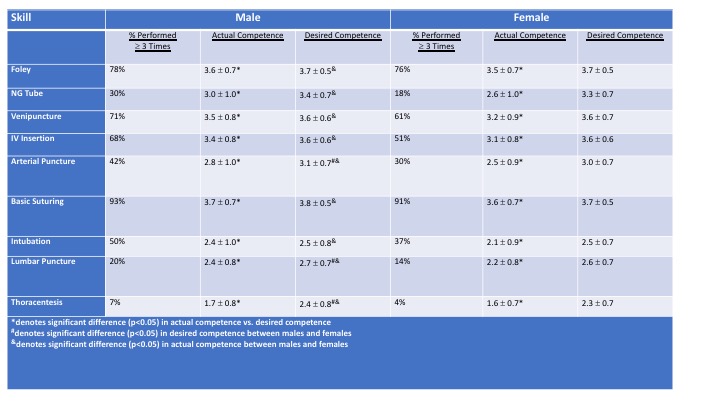PS6-06: INFLUENCE OF GENDER ON ACTUAL AND DESIRED PROCEDURAL SKILL ACQUISITION IN GRADUATING MEDICAL STUDENTS
Monica M Grova, MD, Michael O Meyers, MD; University Of North Carolina At Chapel Hill
Introduction: The influence of gender in desired and actual procedural skill acquisition is not well defined. We sought to evaluate whether there was any association in a longitudinal study of graduating medical students.
Methods: Under IRB approval, graduating students at a single medical school were queried over an eight-year period via online survey to assess experience as well as actual and desired competence for nine procedural skills (Table). Data were collected on a 4-point scale (4=independently performs to 1=unable to perform) and analyzed by Chi-square and Student’s t-test.
Results: 844 students responded; 427 (51%) female. Male students were more likely to be pursuing procedural specialties (57% v. 48%; p=0.03) although those pursuing surgical specialties was identical (26%). Both male and female students reported PGY2 and above residents were most responsible for teaching procedural skills (72% vs. 71%; p=0.94). Both male and female students had a higher mean desired competence compared to actual competence for all skills (p<0.05 for all). (Table) Men had a slightly higher desired competence for arterial puncture, lumbar puncture and thoracentesis (p=0.02 for all). (Table) Men were more likely to report a greater number of procedures performed for all skills except Foley placement, basic suturing lumbar puncture and thoracentesis. (Table) Correspondingly, men were much more likely to have a higher perceived actual competence for all procedures (P<0.001 for all). (Table) Similarly, male students were more likely to consider themselves independent for all skills except Foley placement and lumbar puncture.
Conclusions: Both male and female students had greater desired than actual competence for all skills. Male students had greater self-reported actual confidence than female students which corresponded to greater procedural volume.

